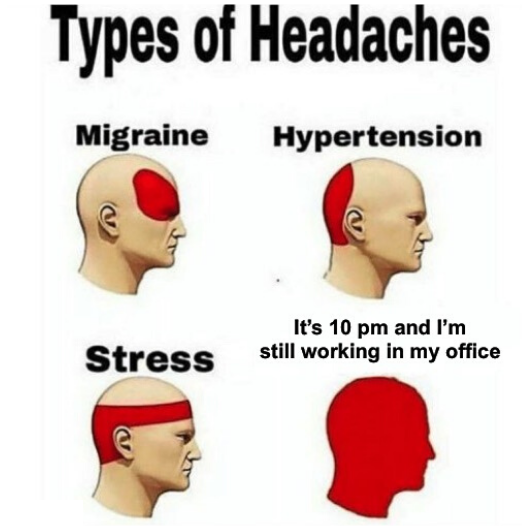Headaches – types, causing, and management
It is undoubtable that headache is one of the most unpleasant experience in our life. There are more than 170 types of headaches, this article is going to introduce four of the most common headaches.

Tension headaches
Tension headaches, also known as stress headaches, are the most common type of headache among adults and teens. According to the research, approximately 80% of adults have tension headache, and female are twice likely to get them as male.
Tension headaches cause mild to moderate pain and come and go over time, and they usually don’t affect our vision and balance. People usually feel dull pain, tightness, or pressure around your forehead or the back of your head and neck. Some people may describe it as a clamp squeezing the skull.
Generally, the pain episode lasts 30 minutes to a few days, without vision and balance disturbances.
What caused tension headache?
Although there is no clear cause of tension headaches, most of the episodes are triggered from:
-Stress from work, school, relationships or family
-Tightened back or neck muscles due to insufficient rest
-Bad posture
-Alcohol
-Anxiety
-Emotional stress
-Jaw problems
Migraine headaches
Migraine headaches are often described as pounding, throbbing pain at the side of the head. Other associated symptoms include: vomiting, nausea, dizziness, eye pain, phonophobia (sensitivity to sound) and photophobia (sensitivity to light). According to Headache Australia, over 3 million Australians suffer from migraine headache, from childhood to late 40s.
What causes migraine headache?
Migraine headaches can be triggered by:
-Dietary
-Environmental
-Hormonal
-Physical and emotional triggers
Cluster headaches
Cluster headaches can be classified as a series of short but extremely painful headaches, which could onset from everyday, weeks or even months. Because of its seasonal episode, many people mistake cluster headaches for allergies. Scientists attribute facial nerves as the primary cause of pain. In some cases, cluster headaches can be more server than migraine headaches.
What caused cluster headaches?
Cluster headaches are caused by the trigeminal nerve (CN V), which is located at the side of our head and is responsible for sensations in our face and eyes. Cluster headaches are triggered by strong light and smell.
Cervicogenic headache
If your headache is related to a problem in your neck, there’s a good chance it’s a cervicogenic headaches.
A specific sign of cervicogenic headache is that it comes from certain movements of your neck, a sudden neck movement, or you remained your neck in a same position for long time.
What caused cervicogenic headache?
There are many potential possibilities can cause cervicogenic headaches:
-Jammed cervical facet joints
-Tight neck muscles
-Cervical nerve impingement
-Sports injury
-Whiplash
-Arthritis
-Prolonged use of mobile phone
Some occupations have higher risk getting cervicogenic headache than others, especially when you need to bend your head down or keep it low for long time:
Truck drivers, Dentists, Hair Stylists,
How do we manage headache?
- Manual therapy( Physiotherapy and Osteopathy)
- Remedial massage
- Medication
- Posture
- Temperature
- Exercise (Neck and back muscle strengthening)
- Lifestyle changes
- Emotional management (leave away form what makes you feel stressful)
Back to Active Sports and Spinal provides multiple health professionals that perform full body biomechanical assessments and evidence based treatment plans for you to address your headache and bring your a pain free life.
Written by Dr Wei ‘David’ Tai Osteopath
